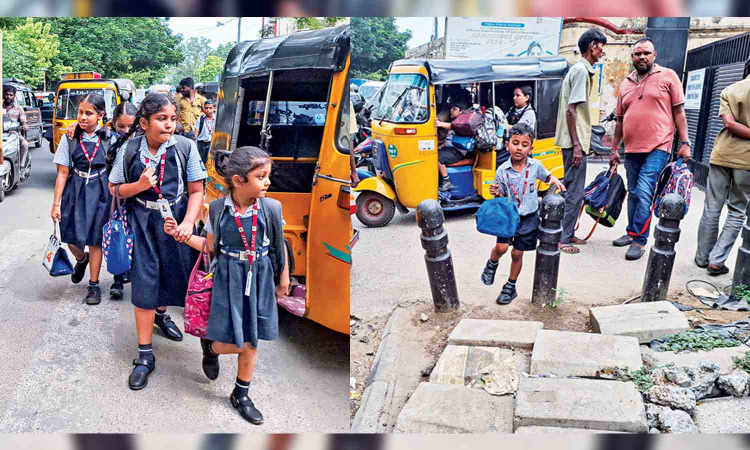Once again, traffic police plan 25 safe school zones
Initiative began in 2022; expect traffic regulations and infra upgrades in a collaboration between Chennai traffic police, CUMTA and the local body

Representative Image
CHENNAI: Every day, picking up your wards and dropping them off at school is a stressful time for both parents and drivers, who find it challenging to navigate public roads. With thousands turning up at the same time, chaos ensues and creates traffic logjam for several kilometres.
To resolve this issue, the Greater Chennai Traffic Police (GCTP) has begun identifying ‘safe school zones’ across the city, and have now narrowed it down to 25 schools in the first phase.
“The initiative, to be undertaken in collaboration with the Chennai Unified Metropolitan Transport Authority (CUMTA) and the Greater Chennai Corporation (GCC), will involve traffic regulation and infrastructure upgrades,” said Joint Commissioner of Police (Traffic-South) Bandi Gangadhar, IPS, on Tuesday.
The announcement was made at the release of a report by Citizen Consumer and Civic Action Group (CAG) on safe school routes. The study, based on three schools – one each in T Nagar, Broadway and Chetpet – underscored how poor infrastructure and weak enforcement make commutes unsafe for children. “I will not allow my kids to cycle to school in current conditions,” the JCP added.
This is not the first time such promises have been made. Since 2022, CUMTA has worked on ‘safe routes to schools’, commissioning studies in KK Nagar, piloting redesigns in Gopalapuram, and exploring measures such as vehicle-free buffers and flashing signals. Most of these efforts, however, have remained in the pilot stage. Officials attribute one of the reasons for the delay to poor cooperation from school management.
“A popular school in Gopalapuram has not cooperated fully with the plan. They park buses right at the gate, worsening congestion. Such vested interests are among the reasons for poor implementation,” said a CUMTA official. “The pickup and drop-off points should be at least 50 metres from the school gate to ease traffic.”
Now, GCTP, GCC and CUMTA have once again started drawing up standard design plans for school safety zones across the city. Proposals include footpath widening, safety signages and markings, speed limits, and dedicated parking bays.
ACP Bhaskar from the traffic planning wing added, “Around 300 volunteers from the Tamil Nadu Police Traffic Warden Organisation will also be deployed in schools to educate children on traffic rules and civic sense.”
The report found that nearly half of the families lived within 1 km of the campus and another quarter within 2-5 km. Despite the short distances, a significant number of parents said walking or cycling to school was unsafe. Around a third of children walked and another fifth cycled, while the rest depended on two-wheelers, autos and buses.
And, yet, between 68 and 79% of parents across the three schools reported that their children struggled to cross the road. Congestion during pick-up and drop-off hours, unsafe U-turns at school gates, absence of proper drop-off zones, and footpaths that were either encroached or missing were the concerns most frequently cited.
The study also pointed to the direct impact of this congestion on air quality. At Broadway, for instance, PM2.5 levels spiked to 269 mg/cubic metre during morning drop-off, while in Chetpet the average was 189 mg/cubic metre during dispersal time – both many times higher than the WHO’s recommended limit.
Parents consistently called for congestion management, continuous footpaths, stricter enforcement of speed limits and traffic police presence. The report recommended designated pick-up and drop-off zones, no-parking enforcement through ANPR cameras, and a 25 kmph speed limit in school zones.
But the larger question is one of delivery. Though the current study covered only three campuses, its findings mirror what parents across Chennai have long complained of. With several pilots and redesigns already attempted, the onus is on the GCC to deliver a safe space.
SURVEY FROM 3 SCHOOLS
How children travel
· 36% walk
· 16–20% cycle
· 20–29% two-wheelers (parent drop)
· 15% autos
· Others use MTC buses/vans
Where they live
· 40–48% within 1 km
· 25–28% within 2–5 km
Parents’ top concerns
· Unsafe crossings: 68–79%
· Congestion during drop-off/pick-up: 23–29%
· Unsafe U-turns: up to 31%
· Lack of drop-off zones: 24%
· Encroached footpaths common across all schools
School-specific snapshots
Broadway (St Gabriel’s): PM2.5 hit 269 µg/m³ at morning drop-off; 1,019 vehicles counted at dispersal
T Nagar (Ramakrishna Mission): 79% parents reported unsafe crossings; 31% flagged U-turns at gate
Chetpet (Maharishi Vidya Mandir): Footpaths missing; PM2.5 averaged 189 µg/m³ during dispersal



